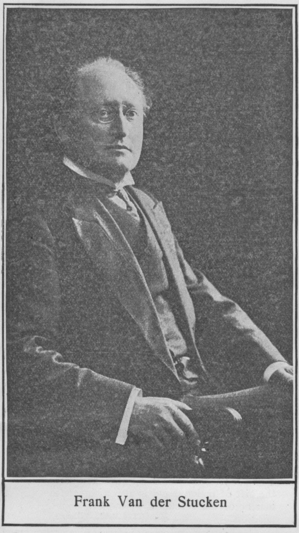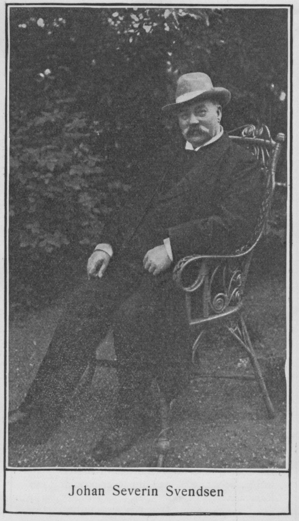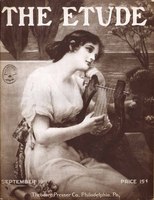Van der Stucken was born at Fredericksburg, Gillespie County, Texas, October 15, 1858. His father was a Belgian and his mother a German. After the Civil War the family returned to Europe during his eighth year. Van der Stucken became a pupil of Bénoit at Antwerp, but later went to Leipsic, where he became a pupil of Reinecke, Grieg and Langer. He had already produced various compositions which had been favorably received, and in 1882 he became director of music at Breslau City Theatre. During 1883 he spent a short period in Rudolstadt with Grieg and at Weimar with Liszt, who befriended him at this time. The year following he was appointed conductor of the Männergesangverein Arion of New York. In 1895 Van der Stucken was appointed director of Cincinnati Conservatory, and also became the first conductor of the Cincinnati Orchestra. He succeeded Theodore Thomas as director of the Cincinnati May Musical Festivals in 1906, but in 1908 retired and returned to Europe. As a composer he has not written a great deal, but what he has done has been well done. He has written music to Shakespeare’s Tempest, and the orchestral pieces, Idylle, Pax Triumphans, William Ratcliffe, etc. His other works include male voice choruses, such as the Bundes Hymne, and songs such as The Sweetest Flower that Blows, Fallih Falloh and Come with Me in the Summer Night. Van der Stucken has the gift of melody, and is also a complete master of the resources of modern composition.
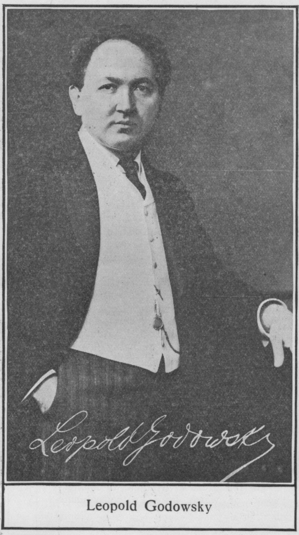 LEOPOLD GODOWSKY.
LEOPOLD GODOWSKY.
(Go-dof’-ske.)
Godowsky was born at Wilna, Russian Poland. February 13, 1870. He early showed great aptitude for music and first appeared in public as a pianist in Wilna in 1879. He then toured Poland and Germany, with great success. Through the generosity of a Königsberg banker he was enabled to go to the Berlin Hochschule. where he was a pupil of Bargiel and Rudorff. He made his first American tour in 1884, in company with Ovide Musin. Two years later he became a pupil of Saint-Saëns in Paris. He then toured France and England, with great success. Godowsky returned to America in 1890. He lived successively at New York, Philadelphia and Chicago (where he was leading teacher in a conservatory), and also toured the United States and Canada. The year 1900 was perhaps the turning point in his career, for it was then that his playing created a sensation in Berlin and secured him a place in the foremost rank of living pianists. At present he lives in Vienna, where he is head of the piano department of the Imperial Academy. As a pianist he possesses an all-comprehensive touch and unusual command over the gradations of tone. He is also able to manipulate many themes simultaneously. He has written a number of works for the piano, the most remarkable being his arrangements of the Chopin etudes. In these he exhibits the greatest freedom in counterpoint, of which he is a consummate master.
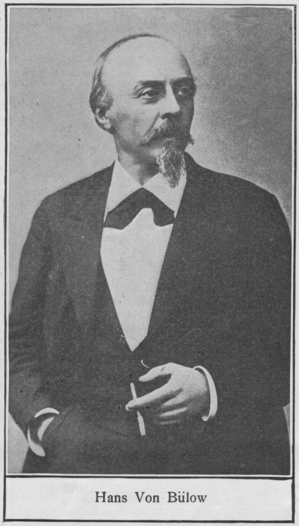 HANS GUIDO VON BÜLOW.
HANS GUIDO VON BÜLOW.
(Bee’-loh.)
Von Bülow was born January 8, 1830. at Dresden, and died at Cairo, Egypt. February 12, 1894. He studied first under Friedrich Wieck, Hesse, Hauptmann and Plaidy. He commenced his career as a writer on politics, but soon was attracted to the following of Liszt and Wagner. After studying with Liszt at Weimar in 1851 he went on tour (1853), and quickly came to the front. During his long career he held several important posts as a professor of the piano, and was director of the Munich Royal Conservatory from 1867 to 1869. He was also associated at different periods with Raff at Frankfort, Klindworth at Berlin, etc. Before directing the Munich conservatory he was principal conductor at the Munich opera, and inaugurated some model productions of Wagner’s Tristan and Die Meistersinger. In 1880 he was appointed capellmeister to the Duke of Meiningen, and for the next five years brought the orchestra of the court up to a magnificent pitch of perfection. He visited America in 1875-6 and gave 139 concerts. Dannreuther said of him that he played and conducted “with passionate intellectuality.” His powers of memory were phenomenal, and he had great analytical gifts. These gifts are well illustrated in his careful editing of the music of Beethoven, Bach, Handel, Scarlatti, etc., as well as in his piano arrangements of Wagner’s Tristan und Isolde, the Meistersinger overture, etc. He endured much ill health, and was feared for his mordant wit.
Thomson was born at Liège, Belgium, March 18, 1857. He studied first with his father, and then with Dupuis at the conservatory in Liège. He soon made astonishing progress, and at the age of fourteen possessed a technic far in advance of the rest of the conservatory students, many of whom have since become famous. Later he studied interpretation with Léonard, but his particular specialty has always been his colossal technical powers. In 1875 Thomson went to Italy, becoming a member of the private orchestra of Baron de Derwies. He became concertmeister of the Bilse orchestra in Berlin in 1882, but after successful appearances at the annual musical festivals at Brussels he became professor of the violin at the Liège conservatory. In 1897 he left Liège, and the following year he succeeded Ysaye as principal violin professor at the Brussels conservatory. He has traveled extensively in Europe and in America, and has always been successful. He is at his best in works which demand an inexhaustible technic, and is a brilliant exponent of the works of Paganini, whose compositions he revived at a time when they were almost forgotten. He has a large following of pupils, whom he instructs in technic rather than emotional expression. His critics assert that Thomson is too “cold,” but those who admire absolute mastery of the instrument combined with emotional restraint have found much to admire in Thomson’s playing.
Svendsen was born at Christiania, Norway, September 30, 1840, and died June 14, 1911, at Copenhagen. He was the son of a military bandmaster, and composed a violin piece when he was eleven. For a time he followed his father’s profession, but soon gave it up. At the age of twenty-one the “wanderlust” seized him, and he lived promiscuously until he found himself destitute in Lübeck. Here a “fairy godmother” in the shape of the Norwegian Consul took pity on him, and enabled him to secure a stipend from Charles XV to aid him in violin study. Paralysis in the hand compelled him to give up the violin, and he went to Leipsic in 1863 to study composition under Richter, Hauptmann, David and Reinecke. He spent more years in travel and made many valuable friends, including Liszt and Wagner. Svendsen visited America in 1871, and returned to Europe with an American wife. Among other organisations, he conducted the Euterpe Society at Leipsic, and during 1872-77 he conducted the Christiania Musical Association. He received a government pension in 1874, and after more touring settled down in 1883 as court conductor at Copenhagen. His compositions include two symphonies, the Carnaval à Paris for orchestra, Norwegian rhapsodies, choruses, shorter orchestral works, songs, etc., and the ever-popular Romance.
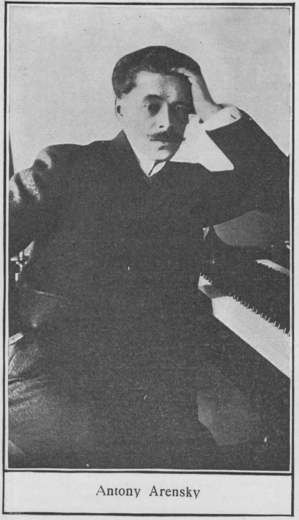 ANTONY STEPANOVITCH ARENSKY.
ANTONY STEPANOVITCH ARENSKY.
(A-ren’-ske.)
Arensky was born at Novgorod, July 31, 1861, and died at Terioki, Finland, February 25, 1906. He was a pupil of Zikke, and later (1879-82) of Rimski-Korsakoff at the St. Petersburg Conservatory. In 1882 he was appointed professor of harmony and counterpoint at the Moscow Conservatory. Arensky became a member of the Council of the Synodal School of Church Music at Moscow in 1892, and remained in this position until 1893, and was also for seven years conductor of the concerts of the Russian Choral Society in Moscow. He became director of the imperial chapel in St. Petersburg in 1894, and was succeeded by Smolensky in 1901. As a composer Arensky has become widely known, and is one of the most representative of the modern Russian school. In some respects he has been influenced by Tschaikowsky, though he possesses decided individuality. His works include three operas, in one of which—A Dream on the Volga—he makes remarkable use of Russian folk-songs. Other works in larger forms include two symphonies, a pianoforte concerto, choral works and a considerable quantity of choral music, mostly of a sacred kind. His shorter piano pieces are very well liked by pianists, and include such favorites as Au pres de la mer, Basso Ostinato, the etude in F sharp, the waltz in E flat and Bigarrure. The suite for two pianos is also very popular.


